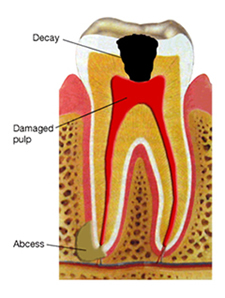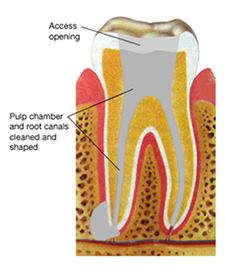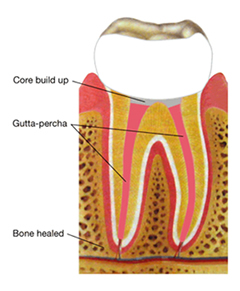Root Canal Therapy
First, a comprehensive examination will take place to diagnose the source of the oral or facial pain. The series of quick painless tests and x-rays will help determine if a tooth needs endodontic treatment.
What is a root canal?
A root canal is a highly predictable procedure with success rates around 90-95% when performed by an endodontic specialist. A root canal is the most affordable way for many patients to retain their natural teeth. A root canal is one of the most common dental procedures with well over 14 million performed every year. Each tooth has a collection of blood vessels and nerves in the center of the tooth called pulp. The pulp can become infection by trauma to the tooth, deep decay, cracks and chips, or repeated dental procedures. A root canal is the removal of this infected tissue and placement of a filling material. Most root canal treatments can be done within one appointment. Symptoms of the infection can be identified as visible injury (discoloration in the tooth), swelling around the tooth, sensitivity to temperature or pain in the tooth and gums. Many patients report that the tooth wakes them up at night.
How is a root canal performed?
If you experience any of the previous symptoms, your dentist will most likely recommend a root canal to eliminate the discomfort in the tooth. Most of our patients are surprised at the ease of the procedures. Wichita Falls Endodontics is committed to exceeding your expectations.
 |
Since, endodontic treatment is necessary when the pulp becomes inflamed or infected, Wichita Falls Endodontics uses special local anesthesia to eliminate any discomfort. A rubber dam is placed around the tooth to act as a protective barrier for the patient and to prevent saliva from entering the tooth. Then a small hole is placed through the crown of the tooth and the infected pulp is removed. |
 |
Very small instruments are used to clean the pulp and roots through the crown of the tooth and within the roots. This space is enlarged to remove any additional bacteria and special medication is placed within the tooth to disinfect and soothe the tissues. |
 |
After the spaces have been cleaned out and shaped properly, Dr. Baker fills the root canals with a biocompatible material. The filling material is placed with an adhesive cement to ensure complete sealing of the root canals. A temporary filling is placed to close the opening, which will be removed by the dentist when placing the permanent restoration. |
The entire root canal procedure is usually completed in one appointment and typically takes less than an hour and a half. Most of our patients are pleasantly surprised at the ease and quickness of the procedure.
What happens after treatment?
When your root canal therapy has been completed, original radiographs and a record of your treatment will be sent to your dentist. Wichita Falls Endodontics has seamless software management that allows your dentist to be involved during each step of the procedure. You may need to contact the dentist for the permanent restoration (filling or crown). Your restorative dentist will decide on what type of restoration is necessary to protect your tooth. If a problem does occur, however, we are available at all times- before and after your treatment.


